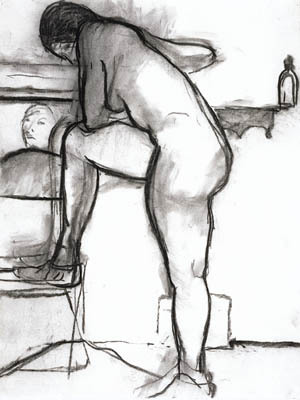A question that has been on my mind of late.. What drives some artists to output work with almost rapid abandon, and others who feel driven to continually re-state, re-work or edit their work?
This is something that I often contend with in the studio, wondering how to strike some balance between bursts of activity and the need to reflect, critically adjust and reshape the output.
So I turned to the work of Richard Diebenkorn (1922-1993).
Had I paid more attention during art history lectures, perhaps I would not have overlooked the significance and strength of this American artist's work.
His drawings strike a strong chord with me as I struggle to balance creative impulse with the rigour of critical revision. As those who have drawn from life will know, forceful and convincing studies of the human form are rarely as simple as the medium (charcoal in this instance) might suggest - as in the following work:
Seated Nude 1966
You can see and almost feel the vigour of Diebenkorn’s thoughts and hand as they interrogate and study human form. The marks which seem to randomly cut across the surface are sensuous without being sentimental – their primary focus is on the overall sweep, weight, presence and gesture of the human subject – a way of responding to both the subtle and bold rhythms inherent in the body.
What does it remind me of ? That each model, each person has their own unique way of projecting this energy so that no two encounters with a live model ever have to be the same. And the work itself can be a testament to that.
Reclining figure1 1962
I love this drawing for all its energy and bold declarations of the reclining form. There is no overworked emphasis on the light, texture or surface of or around the figure. In fact in parts of the drawing it is form itself that appears to be shifting and disintegrating; Diebenkorn's marks have responded to the restlessness and transient nature of the naked human subject (even when drawing or painted from memory, the works project a force and energy one learns to respond to and translate only through observational/life drawing).
There are parts of the work that are erased, omitted or obscured and which inherently lend the works their own sense of mystery and suggestion. But essentially the marks are expressed as marks, the nature of his response and interpretation as the artist are laid out for us with an intensity and rawness that is present in most great drawing.
Untitled (n.d.)
It drives home the lesson that to have the doggedness and courage to reexamine and revise your work is like mining for its true character, believing that out of the process will emerge the constants which define that character.
So the compulsion to revise, adjust and re-examine your work is not all madness or vanity. This method of change itself has the potential to invest the work with meaning.
And that inspires me.


